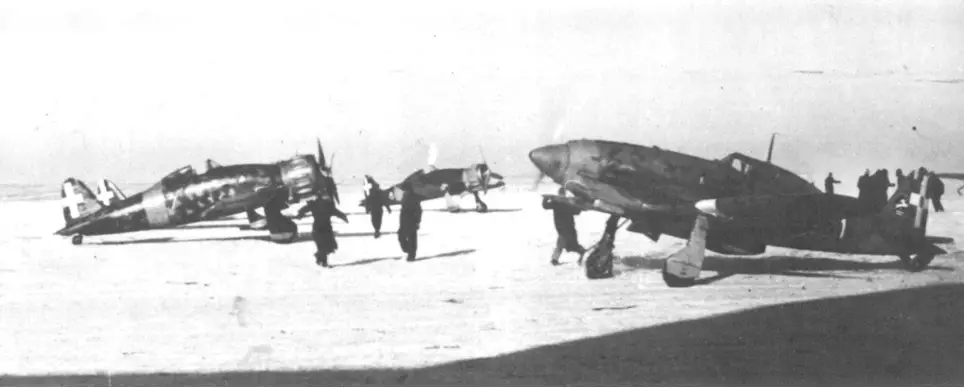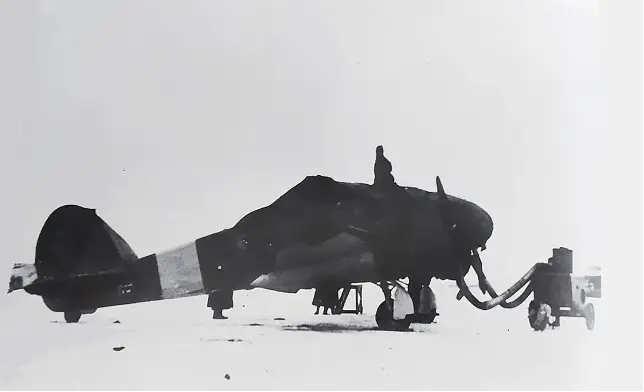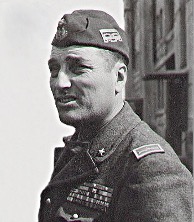In June 1942, the C.S.I.R. was nominally disbanded and with the arrival of new fresh troops (including the Alpine divisions Julia, Tridentina, and Cuneense), the 8th Italian Army in Russia (ARM.I.R.) was formed.
The Army was 227,000 men strong, placed under the command of the elderly General Italo Gariboldi, while General Messe later returned to Italy and participated to the Tunisian campaign. As for the air units, that had taken part in the operations until summer of 1942, the 22nd Fighter Group, worn out by months of activity, was replaced by the 21st Fighter Group, flying on Macchi MC200 (made of four Squadriglie of 12 aircraft each). The 71st Aerial Observation Group flying on Caproni Ca311s (formed by the 38th and 116th Squadriglia) replaced the 61st.
Between August and December 1942, the 71st Group received 12 heavier twin-engine Fiat BR20M bombers and reconnaissance aircraft, while the 21st Fighter Group was supplemented with a handful of new and more modern aircraft: 12 Macchi MC202 fighters. Meanwhile, ARM.I.R. reached the middle course of the Don River, positioning itself defensively between the 2nd Hungarian Army (to the north) and the 3rd Romanian Army (to the south).

Figure 1 MC200 and MC202 fighters over an Italian airport in Russia covered by snow
In August, during a massive and prolonged attack by numerous Soviet infantry and armored divisions against ARM.I.R.’s lines, the entire Italian Air Corps was thrown into the battle to support the ground troops’ resistance. On August 6, the Fiat BR20Ms of the 38th Squadron of the 71st Aerial Observation Group carried out a first bombing mission east of the Don River, targeting concentrations of Soviet artillery and infantry. Similar actions were carried out by the Macchi MC200s (equipped with two 50-kilogram wing bombs) and even the small Ca311.
After two months of intense activity, the early Russian winter further worsened the conditions of the already strained Italian air units (especially the fighter units), which, despite achieving notable successes (not less than 30 enemy aircraft were shot down in combat), saw their ranks reduced to a minimum. However, thanks to the arrival in September of some additional Macchi MC202 fighters, the 21st Fighter Group regained some strength and began a series of low-altitude attacks against Russian positions east of the Don to harass the enemy positions, which at this time was beginning to amass huge numbers of men and tanks for their upcoming offensive.
Between mid-October and mid-November, all the Macchi MC200s and MC202s and the Fiat BR20s persisted in their low-altitude attacks, targeting mainly motorized columns and troop concentrations, despite heavy losses inflicted by Russian aviation and deadly anti-aircraft fire. The results obtained by the Italian pilots were positive compared to their small numbers, however they were insufficient to significantly weaken the powerful Soviet wa rmachine.
On December 11, after a devastating artillery preparatory fire, the Soviets went on the offensive with the support of 750 heavy T34 tanks. After a week of fierce fighting, the Russian divisions (supported by no less than 800 combat aircraft) broke through the central part of the ARM.I.R. front. With a gigantic pincer maneuver, the 6th Army and part of the 1st Army attempted to encircle the entire 8th Italian Army in a vast pocket.

Figure 2 A Ca 311 running a pre-warming procedure of its engines
The maneuver succeeded, but General Gariboldi tried to establish some rear defensive lines (mainly entrusted to the Alpine groups of the Julia, the Monte Cervino Battalion, and the Vicenza reserve division) to allow the bulk of the 8th Army to leave the right bank of the Don and its tributary Kalitva, retreating westward: the only possible maneuver since both the 2nd Hungarian Army and the 3rd Romanian Army had succumbed to Russian pressure. During those days, what remained of the Italian Air Corps in Russia exhausted all its energies in a nearly continuous series of low-altitude attacks against the Soviet armored and motorized units that were spreading into the 8th Army’s rear. With temperatures plummeting to 40-45 degrees below zero, with landing gear and weapon mounts frozen (at those temperatures, the lubricating oils supplied to the Regia hardened, turning into a sort of glue), the Macchis, Fiat BR20s, and Caproni Ca311s still took off from snow-covered fields under Russian fighter-bomber attacks to try to support the remaining Italian defensive positions. However, it was a futile and unequal struggle.
By the end of December 1942, the units had an average of no more than 50 operational aircraft daily, against an opponent capable of deploying no fewer than 400/500. The Macchi MC200 fighters, which, did not have an enclosed cockpit, forcing pilots to endure frightful temperatures in flight, strafed and bombed (always with the small and insufficient 50-kilogram bombs) the Russian columns, supported by the very few more modern MC202s, which were also tasked with facing the enemy fighters. The Russians threw hundreds of Yakovlev Yak-1, Yak-3, and Yak-9, Lavochkin LaGG-3 and LaGG-5, and Mikoyan-Gurevich MiG-3 fighters into the fight, armed with heavy 12.7 mm machine guns and 20 mm cannons. The Russian air force also pounded the Italian rear and retreating columns with compact swarms of heavy assault aircraft and medium twin-engine bombers like the Ilyushin IL-2 “Shturmovik” and Petlyakov Pe-2.
Despite the overwhelming Russian superiority, the 21st Fighter Group’s pilots, thanks also to the tireless work of ground personnel, managed to keep a couple of squadrons operational, while the surviving Fiat BR20s and Capronis attempted with some isolated actions to bomb the Russian armored concentrations close to annihilating the besieged Italian units.
The few SM81 transport trimotors were tasked with providing minimal logistical support to our troops: a task carried out at the cost of heavy losses. But it is worth pausing here to highlight the often overlooked valuable role played by the Transport Group of the Italian Air Corps in Russia: a small unit that, despite great sacrifices, worked hard, despite enemy fighters, to support ARM.I.R. Between December 18 and 21, 1941, the SM81s distinguished themselves by evacuating the Kantemirova airfield, surrounded by Soviet armored troops, rescuing pilots, specialists, and over 70 severely wounded. Between late 1941 and early 1942, during the first great Russian winter offensive, the slow but robust Savoia Marchetti trimotors continued to supply food, medicine, and ammunition to the Italian front lines, losing at least six aircraft, three of which were shot down by Soviet anti-aircraft fire, and damaging the remaining ones.
The commander of the Italian Air Corps in Russia, General Enrico Pezzi, himself disappeared aboard one of the SM81s during a daring supply mission to a large isolated Italo-German unit. On December 29, 1942, in Tscerkow, 7,000 Italians and 4,000 Germans were trapped by a maneuver of Soviet armored units. Pezzi, did not hesitate and decided to personally participate in the rescue mission. On December 29, he took off from Woroscilovgrad with his trimotor, carrying Lieutenant Doctor Federico Bocchetti and pilots and specialists Romano Romanò, Giovanni Busacchi, Luigi Tomasi, Antonio Arcidiacono, Salvatore Caruso, and Alcibiade Bonazza. The aircraft, loaded with food and medicine, reached Tscerkow, then took off with several wounded to try to reach the rear lines but failed. General Pezzi’s SM81 disappeared into thin air, probably shot down by Russian fighters.

Figure 3 General Enrico Pezzi
After a long and arduous operational cycle, at the beginning of 1943, the last battered SM81 transports had to gradually retreat to less exposed fields to the final Russian offensive. They abandoned Stalino, one of the main rear bases along with other surviving units of the Italian Air Corps, and retreated in the Odessa airport, where they remained until March 1943. The last SM81s of the 246th Squadriglia returned to Italy only in May. The annihilation of the entire Italian Air Corps in Russia occurred, as we have seen, between December 1942 and January 1943, when the great Soviet advance and the general retreat of Hungarian, Italian, Romanian, and German forces coincided with the full force of the Russian air force.
The numerical comparison between the air units of the opposing sides on the Don front was overwhelmingly unfavorable. Against a Russian air army equipped with over 2,000 fighters, fighter-bombers, bombers, and reconnaissance aircraft, the sparse Italian, German, Romanian, and Hungarian groups could muster only 300 operational aircraft, which were short of fuel, ammunition, and spare parts. This staggering disparity was primarily due to the Luftwaffe Command being forced to deploy nearly all its units to support Von Paulus’s 6th Army besieged at Stalingrad and Von Kleist’s army engaged further south in the Caucasus area between December 1942 and January 1943.
The last significant military action of the Italian Air Corps in Russia occurred on January 17, 1943, as the tragedy of the ARM.I.R. was nearing its end. On that day, a mixed formation of 25 MC200 and MC202 fighters from the 21st Group (which then had a total of only 30 MC200s and 9 MC202s) attacked a strong Soviet armored and motorized column, inflicting significant losses on the enemy. However, the lack of spare parts, fuel, lubricating oils, and ammunition forced the units to suspend activities and retreat to fields less exposed to the Soviet offensive. Between March and May of the same year, the remnants of the fighter units and the entire Italian Air Corps in Russia returned to Italy.
Sources
Grienti, V., Verde, P., (2024), La Regia Aeronautica nella Campagna di Russia (1941-1943)
Rosselli, A., Breve storia del Corpo Aereo Italiano in Russia 1941-1943
Malizia N., (1987) Ali sulla Steppa, la Regia Aeronautica nella Campagna di Russia